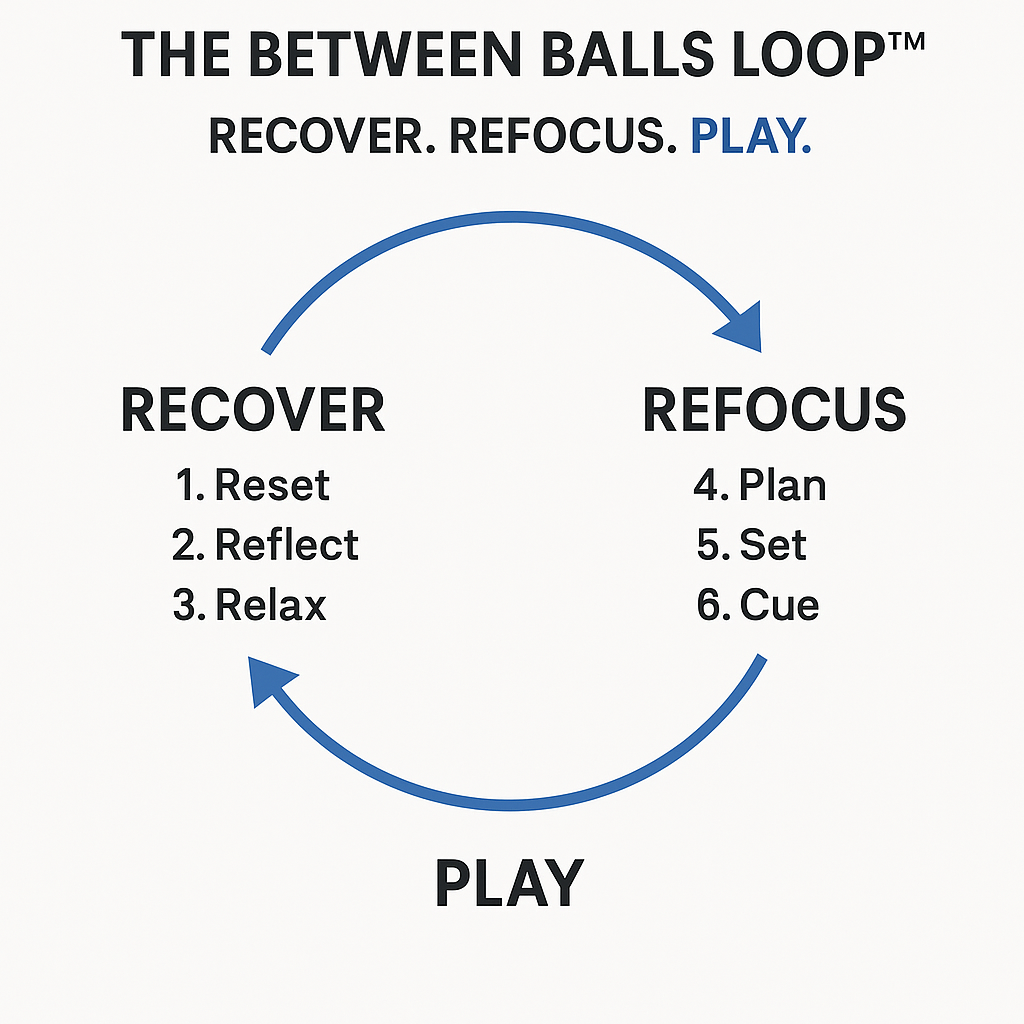
I hope you take pleasure in studying this weblog put up.
James Breese, Cricket Issues Founder
For those who want my assist with cricket teaching, energy and conditioning, damage rehab, or vitamin, click on right here.
It’s not the flashy cowl drive that wins matches.
It’s the house between balls—when nothing’s taking place—the place video games are received or misplaced.
That’s the place focus slips. That’s the place matches unravel.
Most batters don’t fail as a result of they lack ability. They fail as a result of they lose management of their thoughts between deliveries.
They get caught previously. Or bounce into the long run. They suppose an excessive amount of. Or under no circumstances. And all of the sudden, they’re strolling off, questioning how they let it slip.
Nevertheless it doesn’t need to be that method.
What you do between balls is a ability. And like several ability, it may be educated.
This isn’t about mindset principle or motivational fluff. It’s a sensible, field-tested psychological routine high-performing cricketers use to remain composed, locked in, and able to carry out—one ball at a time.
It’s easy, repeatable, and private. As soon as you put in it, every thing about the way you bat adjustments.
On this article, I’ll stroll you thru the six-step psychological routine for batting that bridges the hole between chaos and readability.
Whether or not you’re a younger participant simply beginning, a membership cricketer chasing consistency, or a coach working with creating athletes, this routine works.
As a result of it’s constructed on how the mind performs beneath strain, and it’s been pressure-tested, ball after ball, on actual fields with actual gamers.
Key Takeaways
- Uncover the 6-step psychological routine elite cricketers use to remain calm, centered, and prepared between each ball.
- Discover ways to practice your thoughts like your method—utilizing construction, not superstition.
- Construct composure beneath strain with a routine grounded in science, not guesswork.

Have You Downloaded Our FREE 7-Day Gymnasium Exercise Plan?
Seize your full step-by-step 7-day gymnasium exercise plan for cricketers in the present day. There will likely be no extra Guesswork. Simply observe the plan and get outcomes.
Desk of Contents
Why the Psychological Facet of Batting Issues

Batting is greater than method. It’s greater than drills, reps, and excellent swing paths. When the strain’s on, your mindset determines what occurs subsequent.
Cricket is a recreation of decision-making, ball after ball. Do you play? Do you allow? Do you commit or wait?
These selections don’t simply come from intuition. They arrive from readability. And readability solely exists when the thoughts is calm.
That’s the place most gamers lose it. Not with the improper shot—however with the improper state.
They get emotional. They rush. They overthink. One ball turns into two, and shortly a superb innings is gone earlier than it begins.
Watch the greats—Kane Williamson, Joe Root, Steve Smith.
What stands out isn’t simply their method. It’s how composed they’re between deliveries.
They management their breath and physique language. They swap off after which swap again on with intent.
It’s not luck. It’s not persona. It’s a ability.
They use the time between balls to recuperate and reset—mentally and bodily. They don’t carry the final ball into the subsequent one. They step away, re-centre, and return with objective.
That is the place most membership cricketers wrestle.
They practice onerous within the nets, however come recreation time, their thoughts runs forward of them. Or worse, runs away from them.
The actual battleground in cricket isn’t the photographs you play. It’s the house between balls.
Get that proper, and every thing adjustments. Your shot choice improves. Your reactions sharpen. Your confidence grows.
As a result of when your thoughts is in the fitting place, your physique follows.
And that’s exactly what the 6-step Cricket Issues psychological routine is constructed to ship.
The 6-Step Psychological Routine for Batting

Batting isn’t nearly taking part in the ball—it’s about making ready for it correctly. What you do between deliveries units the tone for what occurs throughout them.
This routine is break up into two elements: Get well and Refocus.
The Restoration section goals to bodily, emotionally, and mentally clear the thoughts of the earlier supply.
Within the Refocus section, the main focus shifts to making ready for the subsequent ball with readability and intent.
It’s easy. Repeatable. And highly effective beneath strain.
Right here’s the way it works.
Restoration Section
- 1. Reset: Use a bodily motion to disconnect from the final ball. Stroll away. Alter your gloves. Look out towards sq. leg. No matter works for you. The purpose is to attract a line beneath the earlier second—good, dangerous, or impartial.
- 2. Mirror: Ask your self, “Was I calm, relaxed, balanced?” Not: “Did I play that effectively?” This can be a state verify, not a judgment. If one thing felt off, make a remark. If it felt good, belief it.
- 3. Calm down: Let it go. Drop your shoulders. Hum a tune. Go searching. That is the place you preserve vitality. You don’t want to remain ‘on’ for each second—you could know when to change off.
Refocus Section
- 4. Plan: Determine in your intent for the subsequent ball. Make only one clear plan—not an inventory of what-ifs. Intent focuses your physique and sharpens your response.
- 5. Set: Step into place. Guard. Faucet. Breathe. That is the place you lock again in—bodily and mentally. You’re now not switching off. You’re on the point of compete.
- 6. Cue. Because the bowler runs in, give your self one last instruction on the purpose of launch. A single phrase or phrase. This cue blocks out noise, silences doubt, and narrows your consideration to what issues most.
This routine isn’t about superstition or rituals. It’s about creating construction within the house between balls—so you possibly can present up with readability, calm, and intent for each single supply you face.
Breaking It Down: The Restoration Section

Earlier than you possibly can focus, you could recuperate. That begins with a reset—bodily first, then psychological.
Reset Isn’t Superstition—It’s Technique
Elite batters don’t simply stroll away from the crease as a result of it appears to be like good on digicam. They do it as a result of it really works.
A 2015 research by Abbas & North analysed over 1,000 deliveries in skilled cricket.
They discovered 82% of elite gamers used a constant behavioural routine earlier than going through every ball.
What are the most typical reset actions?
- Strolling away from the crease
- Wanting towards sq. leg
- Adjusting gloves
- Taking a breath earlier than stepping again in
These weren’t quirks. They had been a part of a system, actions that helped gamers mentally separate one supply from the subsequent.
Greater than half of all deliveries concerned gamers repeating the identical sequence.
It wasn’t efficiency theatre. It was efficiency management.
And it acquired sharper beneath strain. 9 of the gamers studied modified their routines barely in tense, strain conditions—switching from foot shuffles to a smaller, extra grounding motion. That’s consciousness. That’s adaptation.
One other report, from sports activities psychologist Dr. Cotterill, confirmed how these routines are constructed intentionally.
He labored with elite cricketers earlier than a season to assist them design private reset actions.
Some tapped the bat. Others took a breath.
One had a triple-check routine:
- Stroll to sq. leg
- Ask: “Was I balanced?”
- Faucet the crease twice
Over time, these reset behaviours grew to become computerized. Gamers who used them constantly reported:
- Higher emotional management after a poor shot
- Sharper focus beneath strain
- Improved decision-making on the crease
Reset isn’t a luxurious. It’s a basis.
For those who’re strolling straight again to your mark with out breaking the second, you’re not in command of your state—you’re using it. And at greater ranges, that may value you your wicket.
The most effective gamers on the planet use reset actions for a motive:
- To let go.
- To breathe.
- To be prepared once more.
Mirror: Consciousness Creates Management
The most effective batters don’t simply handle their method. They handle their state. They usually do it ball by ball.
In a research revealed in PLOS ONE, researchers interviewed elite-level batting coaches—all former worldwide or first-class gamers—about what actually separates prime batters from the remaining (Connor, Renshaw, & Farrow, 2020).
The reply wasn’t simply footwork or shot choice.
It was self-awareness.
The most effective gamers knew precisely how they had been feeling between deliveries. They checked in with themselves. Silently. Constantly.
Questions like:
“Was I in command of that shot?”
“Was I balanced in my setup?”
“Was my thoughts calm earlier than the ball got here down?”
These weren’t consequence questions. They had been course of checks. And that’s what issues. As a result of specializing in inner state—moderately than runs or errors—retains you grounded.
Coaches famous that gamers who mastered this type of reflection had been extra adaptable. They didn’t spiral after a mis-hit. They stayed composed, recalibrated, and moved on.
A second research took this additional.
In a four-week psychological expertise intervention with a state-level ladies’s group, researchers launched strain inurement coaching—a structured method to expose gamers to emphasize in coaching so they may regulate it in matches (van Rens et al., 2020).
The end result?
Gamers reported higher emotional management, improved confidence, and a clearer sense of once they had been beneath strain, and what to do about it.
One participant stated:
“I now know what strain seems like in my physique and how one can spot it.”
One other added:
“Reflecting between balls helps me management the tempo of my ideas.”
These findings reinforce the Mirror step as a sensible device—not only a good thought.
It provides you a second to cease the psychological noise. To evaluate with out emotion and to stick with the method, not the previous.
Calm down: Don’t Keep Switched On

You don’t have to be “on” on a regular basis to carry out. In case you are, you’ll burn out.
That is the place the Calm down step is available in.
It’s not laziness. It’s not shedding focus. It’s strategic. Deliberate. And utterly backed by analysis.
A research by Veness et al. (2017) confirmed that elite cricketers uncovered to only half-hour of psychological fatigue earlier than performing dash and reaction-based duties carried out worse throughout the board.
- Their response time dropped.
- Their operating between wickets slowed.
- And their endurance collapsed.
They weren’t bodily drained. They had been mentally drained.
And in an extended innings, that type of fatigue builds up silently.
That’s why one of the best gamers discover methods to swap off briefly between balls. A second of psychological restoration—earlier than switching again on.
One other research discovered that senior gamers scored considerably greater on “Rest Means” than juniors (Hazra & Biswas, 2018).
The extra skilled the participant, the extra seemingly they had been to let go, breathe, and mentally reset after every supply. It wasn’t pure expertise—it was a ability they’d educated.
And it really works.
In a separate research, university-level cricketers reported utilizing private “anchors” to calm down between balls—like buzzing a tune, staring out on the boundary, or specializing in their breath (Slogrove et al., 2002).
These gamers weren’t trying out. They had been managing depth.
Rest isn’t downtime. It’s a efficiency technique.
- It drops the psychological load.
- It helps you recuperate.
- And it protects your readability, ball after ball.
For those who by no means step again mentally, strain will finally step in.
Breaking It Down: The Refocus Section

Restoration clears the pinnacle. Refocus brings the intent. That is the place you shift from being composed to being harmful.
Plan: One Ball, One Intent
This isn’t about guessing the subsequent ball. It’s about getting into it with readability.
Within the Plan section, your job is to make one clear choice—both:
- Play the ball on advantage with robust intent and focus, or
- Execute a selected plan primarily based on the match scenario, area, or bowler (e.g. “If lengthy on and off are up, I’m coming right down to go over long-on.”)
Each are legitimate. The secret is that you simply choose one, and just one. Most membership gamers ought to deal with simply level one.
The analysis exhibits that gamers who enter every supply with a single intent—reactive or proactive—reply quicker, decide size higher, and execute extra cleanly.
A 2015 research (Stevenson et al.) discovered that elite batters pre-activate their intent primarily based on early visible cues, making ready for front-foot or back-foot motion earlier than the ball is launched.
Novices, against this, react late and hesitate—as a result of they haven’t dedicated to a plan.
This precept extends throughout sports activities.
In baseball, hitters who educated with variable hitting plans (e.g. “pull to proper”, “pop up on objective”) grew to become extra adaptable and correct (Grey, 2025).
In golf, elite gamers plan each shot, not simply on the whole phrases, however in specifics: “fade to centre of inexperienced with tender fingers.”
That readability builds belief, lowers cognitive load, and sharpens execution.
Similar in cricket.
Planning isn’t locking your self in. It’s giving your thoughts a job.
“I’m going to paddle sweep this ball”
“I’m going to reverse sweep.”
“I’m going to plan the ball on advantage.”
No maybes. No muddle. Then commit.
You’ll be able to at all times modify if the ball doesn’t match your plan. The most effective batters at all times have a superb plan b.
However in case you wait to resolve mid-flight, it’s often too late.
Teaching tip: Practice with scenario-based plans. For instance:
- In opposition to spin: “Sweep each ball”
- In opposition to tempo: “Present intent”
Construct a psychological library of normal plans. Then belief one every ball.
Backside line: It should be clear whether or not your plan is reactive or proactive. One ball. One intent.
Set: Lock Into Rhythm, Prime the System

You’ve made your plan. Now it’s time to get able to execute.
The Set section is your bridge between intent and motion. It’s bodily, not simply behavior—it’s preparation.
What you do on this second units the tone for the way you progress, the way you react, and the way your mind sees the ball.
In a research of over 1,000 deliveries in first-class cricket, researchers discovered that 63.75% concerned the very same pre-delivery setup:
- Guard verify
- Bat faucet
- Stance adjustment
- Small visible cue (like wanting towards level or the bowler’s hand)
When these behaviours change, they typically correlate with strain or uncertainty (Abbas & North, 2015). In different phrases, when gamers drift from their routine, efficiency tends to observe.
It’s not simply cricket.
In golf, gamers who used constant pre-shot routines (similar grip, breath, stance) improved accuracy and retained efficiency positive factors over time (McCann et al., 2001).
In tennis, basketball, and baseball, athletes bounce the ball, shuffle ft, or repeat gestures—not for present—however to anchor focus and prime motion (Yancey, 2007).
That’s what this step does.
- It’s not superstition. It’s construction.
- It provides the mind a sign: We’re prepared now.
- It provides the physique a rhythm: We all know this sample. Let’s go.
Teaching tip: Assist gamers discover their very own “Set” sequence—2 bat faucets, deep breath, verify guard, tender gaze. Hold it brief. Hold it constant. When issues get loud or rushed, that is their anchor.
Backside line: The Set section is your inner inexperienced gentle. Repeat it. Belief it. Let it carry you into the subsequent ball—prepared, composed, and aligned.
Cue: One Phrase, One Feeling, One Focus

That is the final second earlier than you act. And it’s not nearly what you do—it’s about the way you really feel while you do it.
The Cue section is the place you give your mind one last instruction.
A phrase. A sense. One thing that simplifies your focus and locks you into the fitting mindset for motion.
It could be a technical or perceptual cue:
“Watch.”
“Nonetheless.”
“Decide.”
These assist sharpen consideration and eradicate distractions.
However for others, the cue is concerning the state. It’s not what they should see—it’s what they should really feel.
“Aggressive.”
“Intent.”
“Dominate.”
These aren’t reminders. They’re id triggers.
One phrase that places the physique into the fitting state: calm, quick, highly effective, clear. Not hype. Not over-arousal. Only a clear psychological swap.
And the science helps each.
Researchers have proven {that a} single focus cue improves execution by narrowing consideration (Abernethy & Masters, 2011).
Nevertheless, different research present that gamers who can set off efficiency states—like calmness, aggression, or urgency—utilizing a cue phrase or picture play with extra consistency and emotional management (Neumann et al., 2022).
So what’s your cue?
It could be:
- A phrase for imaginative and prescient (“watch”)
- A phrase for motion (“fingers”)
- A phrase for emotion (“aggressive”)
- A phrase for vitality (“breathe”, “current”)
- A phrase for id (“dominate”)
No matter it’s, it must be yours. One phrase. One intention. One ball.
Teaching tip: Don’t simply ask gamers what they are saying—ask what they really feel once they say it. That’s the true cue. You’re not simply shaping behaviour. You’re shaping id beneath strain.
Backside line: The Cue is your psychological ignition swap. It connects your ideas, physique, and intent—so when the ball is launched, you’re already the place you could be.
How one can Practice the Routine: From Idea to Observe

You don’t rise to the extent of your potential—you fall to the extent of your preparation.
If you would like the routine to carry beneath strain, you should practice it till it turns into computerized.
Right here’s how one can do it.
Section 1: Shadow Batting (No Ball)
Begin easy. No bowler. No ball. Only a bat in hand and full focus.
Shadow bat by all six steps:
- Reset
- Mirror
- Calm down
- Plan
- Set
- Cue
Say every one out loud as you go. This can show you how to change into conscious of the way it feels to step by the method.
You’re not hitting balls but—you’re putting in the software program.
Do that 3–5 instances earlier than each web session till it turns into second nature.
Section 2: Throwdowns with Time Between Balls
Now introduce the ball—however sluggish it down.
- Face 12–18 throwdowns at a relaxed tempo.
- After every supply, give your self 15–20 seconds.
- Emphasise full routine, not outcomes.
This isn’t about quantity—it’s about high quality.
Use this time to get your rhythm. Don’t rush.
Between-ball behaviour is the ability. Hitting the ball is the bonus.
Section 3: Nets with Routine Focus
Again into reside nets—however with a twist.
This time, the objective isn’t runs. It’s routine.
Inform your coach, your associate, and even your self:
“I rating 1 level each time I full the total 6-step routine. Nothing else issues.”
Let the balls come quick, and let the bowlers chirp. Your job is to remain calm, structured, and reset each time.
That is the way you construct match-day psychological health.
Section 4: Situation Stress Drills
Now check it beneath hearth.
Set match situations:
“You’re 45 not out. 3 overs left.”
“6 runs to win. 4 balls left.”
“Spin from each ends. Fielders up.”
Routine should keep intact. There are not any skipping steps or shortcuts. Stress reveals habits. That is the place it both holds or falls aside.
Practice till the construction holds with out considering.
Bonus Problem: The ‘1 Ball at a Time’ Recreation
Set a web of 12 deliveries.
- 1 level for finishing the total routine between every ball
- -1 level in case you rush, skip, or lose the step
- Goal: Hit 10/12 constantly beneath totally different circumstances
Monitor your “focus rating” similar to you monitor your batting stats.
Coach’s Tip: Movie the House Between Balls
Need a true learn on how centered a participant is?
Movie a 6-ball web—however ignore the photographs. Watch the gaps.
Do they breathe? Stroll away? Reset their physique language? Or do they keep locked in place, trapped within the final ball?
If the routine isn’t seen, it isn’t educated.
That is the way you flip the psychological routine from a good suggestion into an actual benefit.
Nobody sees it on the scoreboard. However your common? Your strike fee? Your capacity to remain in and construct an innings?
That’s the place it exhibits up.
The place Gamers Go Incorrect—and How one can Repair It Quick

Each routine breaks down in some unspecified time in the future. Stress, emotion, fatigue—all of them chip away at construction.
Listed here are gamers’ most typical errors with the six-step psychological routine—and how one can repair them.
1. Dashing Underneath Stress
The error: Gamers really feel the sport dashing up. In order that they velocity up too. They skip steps, make poor selections, and lose management.
Fast repair: After each ball, silently rely: One, two, three. Give your thoughts time to breathe earlier than you intend the subsequent ball. Decelerate to play higher.
2. Skipping Mirror
The error: It’s uncomfortable to look inward, particularly after a mistake, so gamers skip the self-check and transfer straight to planning.
Fast repair: Anchor Mirror to a reset motion. For instance: “After I contact my gloves, I ask: was I calm, relaxed, balanced?” Construct the behavior by linking it to one thing bodily. Make it computerized.
3. Cue Phrase Not Working
The error: The cue phrase is simply too mechanical or generic. It turns into background noise as a substitute of a efficiency set off.
Fast repair: Shift from instruction to feeling. Don’t simply say “fingers.” Strive “intent.” “Dominate.” “Calm.” Select a phrase that shifts your state, not simply your swing.
4. Routine Breaks After a Unhealthy Shot
The error: One poor shot, one missed alternative—and the routine disappears. Frustration takes over. Focus unravels.
Fast repair: Make the reset motion your rescue rope.
“It doesn’t matter what occurs, I stroll away, contact my helmet, and begin once more.”
That’s your psychological restart button. Press it each time, particularly after failure.
A routine isn’t there for when issues are straightforward. It’s there for once they’re not.
These fast fixes flip breakdowns into breakthroughs.
The extra you practice them, the stronger your routine turns into beneath strain, fatigue, and hearth.
Your Batting Mindset Is Your Aggressive Edge

This routine isn’t about perfection. It’s about presence.
It’s about being composed when others rush, deliberate when others drift, and clear when the sport will get clouded.
The scoreboard received’t present your Reset. The group received’t hear your Cue.
However ball after ball, these are the selections that form an innings.
Focus isn’t a temper. It’s a behavior. And this routine provides you the construction to construct it.
One ball. One second. One clear thoughts. Many times.
Whether or not you’re a creating participant, a membership common, or somebody chasing the sting at greater ranges, what occurs between the balls is now not invisible. It’s trainable. And it’s yours to personal.
For those who’re severe about taking this additional: attain out to ebook a efficiency evaluation.
Coaches—if you wish to implement this together with your group, get in contact.
The construction is scalable. The influence is measurable. Or just take 5 minutes now.
Write out your model of the routine. Hold it easy, hold it private, after which begin utilizing it in your subsequent web.
That is the work nobody sees. Nevertheless it’s the work that wins you video games.
Practice the house between the balls. That’s the place your edge lives.

Have You Downloaded Our FREE 7-Day Gymnasium Exercise Plan?
Seize your full step-by-step 7-day gymnasium exercise plan for cricketers in the present day. There will likely be no extra Guesswork. Simply observe the plan and get outcomes.
Additional Studying
FAQ’s
How one can Mentally Put together for Batting in Cricket?
Psychological preparation for batting entails greater than motivation; it consists in making a constant day by day routine between deliveries. One efficient technique is a six-step course of that helps gamers reset after every ball and refocus earlier than the subsequent. This routine contains bodily actions to disconnect from the final ball, a short inner reflection to evaluate frame of mind, intentional leisure to cut back cognitive fatigue, and a structured re-engagement plan together with intent setting and a private cue phrase. Analysis in cricket and different sports activities exhibits that such routines enhance composure, decision-making, and consistency beneath strain.
What Ought to Be the Mindset Whereas Batting?
The best mindset whereas batting is calm, centered, and adaptable. Research on elite cricketers spotlight the significance of self-awareness and emotional management throughout innings. Reasonably than focusing solely on outcomes (like scoring runs), prime performers monitor their inner state—asking themselves whether or not they really feel balanced, relaxed, and clear-headed. This helps preserve focus and scale back efficiency nervousness. A useful technique is to make use of a structured routine between deliveries to reset and refocus, permitting gamers to remain current and make higher selections all through the innings.
How Do I Keep Targeted Between Balls When Batting?
Sustaining focus between deliveries requires a deliberate psychological and bodily course of. Analysis exhibits that elite batters use constant between-ball routines involving bodily reset actions (like strolling away or adjusting gloves), reflective self-checks, and leisure methods. These assist them mentally separate one ball from the subsequent. After recovering, gamers refocus by selecting a transparent plan for the upcoming supply, entering into place with intent, and utilizing a private cue phrase because the bowler runs in. This six-step loop prevents overthinking and helps maintain focus throughout lengthy innings.
How Can I Construct a Psychological Routine for Cricket Batting?
To construct an efficient psychological routine for batting, begin by practising six core steps: Reset, Mirror, Calm down, Plan, Set, and Cue. Start by shadow batting and naming every step aloud to construct consciousness. Give your self structured time between deliveries to finish the routine in throwdowns or nets. Concentrate on high quality over quantity. Use scenario-based drills to check the routine beneath strain. Over time, this course of turns into computerized, serving to you handle your mindset, keep composed, and reply higher to in-game challenges. This strategy is backed by area analysis and cognitive psychology.
How Do I Keep Calm and Assured Whereas Batting Underneath Stress?
Staying calm and assured whereas batting beneath strain entails managing your psychological state one supply at a time. Analysis exhibits that batters who develop routines between balls are higher capable of regulate feelings, keep centered, and preserve composure. This contains utilizing bodily reset actions, checking in with how you’re feeling, letting go of stress, and getting into every supply with a transparent plan and cue. Gamers who practice these habits commonly are likely to carry out extra constantly and recuperate quicker from setbacks, as a result of their mindset is structured, not reactive.

